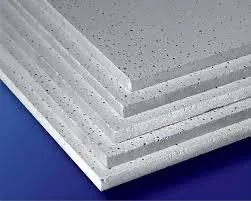Nov . 23, 2024 13:58 Back to list
plaster ceiling access panel
Understanding Plaster Ceiling Access Panels
Plaster ceiling access panels are essential components in modern construction and renovation projects. They provide easy access to hidden spaces above ceilings, such as wiring, ductwork, and plumbing, while ensuring aesthetic integrity in homes and commercial spaces. This article will explore the significance, types, installation methods, and benefits of plaster ceiling access panels.
The Importance of Access Panels
Access panels are crucial for maintaining and servicing the systems that run through ceilings. They allow technicians to perform necessary repairs or inspections without needing to dismantle extensive sections of the ceiling. In the past, accessing these areas could be a hassle, often requiring costly repairs after removing plasterwork. However, with the installation of access panels, this issue is effectively mitigated.
In residential settings, access panels can help homeowners check on electrical systems, HVAC components, or plumbing issues without damaging their ceilings. In commercial spaces, they allow for routine maintenance and easy upgrades, keeping businesses running smoothly without significant disruptions.
Types of Plaster Ceiling Access Panels
There are various types of plaster ceiling access panels available on the market to suit different needs and aesthetics
1. Standard Access Panels These are the most common and consist of a frame and a door that opens to allow entry to the space above the ceiling. They can be made from various materials, including metal and plastic, and are typically designed to blend with the ceiling surface.
2. Fire-Rated Access Panels For areas where fire safety is a concern, fire-rated access panels are essential. They are designed to withstand high temperatures and slow the spread of fire, providing crucial time for evacuation. These panels are typically made from materials that resist fire, such as galvanized steel.
3. Acoustic Access Panels In environments where noise control is critical, such as theaters or recording studios, acoustic access panels are utilized. These panels help maintain soundproofing while allowing access to essential systems.
plaster ceiling access panel

4. Insulated Access Panels In climates with extreme temperatures, insulated access panels help regulate temperature and maintain energy efficiency. They are often used in commercial buildings' HVAC systems to reduce energy costs.
Installation
Installing plaster ceiling access panels can be straightforward but requires careful planning and execution. Here are the basic steps involved
1. Planning Before installation, it’s essential to determine the location of the access panel. Ensure that the area above the ceiling contains the components you may need to access, and check for any structural elements that may interfere.
2. Cutting the Opening Using a drywall saw, cut a hole in the plaster ceiling that matches the dimensions of the access panel. It’s important to make clean cuts to ensure a snug fit for the panel.
3. Framing Add framing around the opening, if necessary, to provide support for the access panel. This can typically be done with wooden or metal supports, depending on the ceiling's structure.
4. Securing the Panel Insert the access panel into the opening and secure it according to the manufacturer’s instructions. Many panels simply fit into place, while others may require screws or adhesive.
5. Finishing Touches Once the panel is installed, touch up the surrounding plaster to blend seamlessly with the ceiling. This step ensures that the panel is discreet and does not disrupt the aesthetics of the space.
Conclusion
Plaster ceiling access panels are invaluable for both homeowners and business owners, providing practicality and convenience in maintenance and accessibility. By understanding the types of access panels available and the installation process, you can ensure that your ceilings remain functional while maintaining a polished appearance. Investing in high-quality access panels is an effective way to enhance the longevity and efficiency of essential systems hidden above your ceilings.
-
Quality Ceiling Trap Doors & Access Panels | Easy & Secure AccessNewsAug.30,2025
-
Durable Ceiling T Grid Systems | Easy InstallationNewsAug.29,2025
-
PVC Gypsum Ceiling: Durable, Laminated Tiles for Modern SpacesNewsAug.28,2025
-
Pvc Gypsum Ceiling Is DurableNewsAug.21,2025
-
Mineral Fiber Board Is DurableNewsAug.21,2025
-
Ceiling Tile Clip Reusable DesignNewsAug.21,2025







